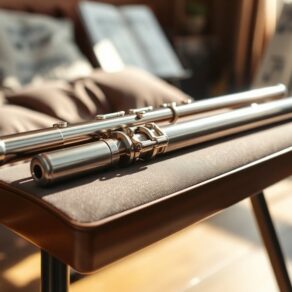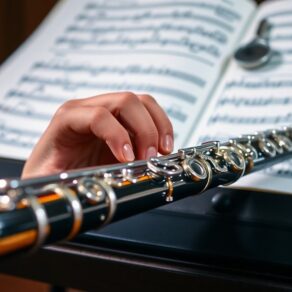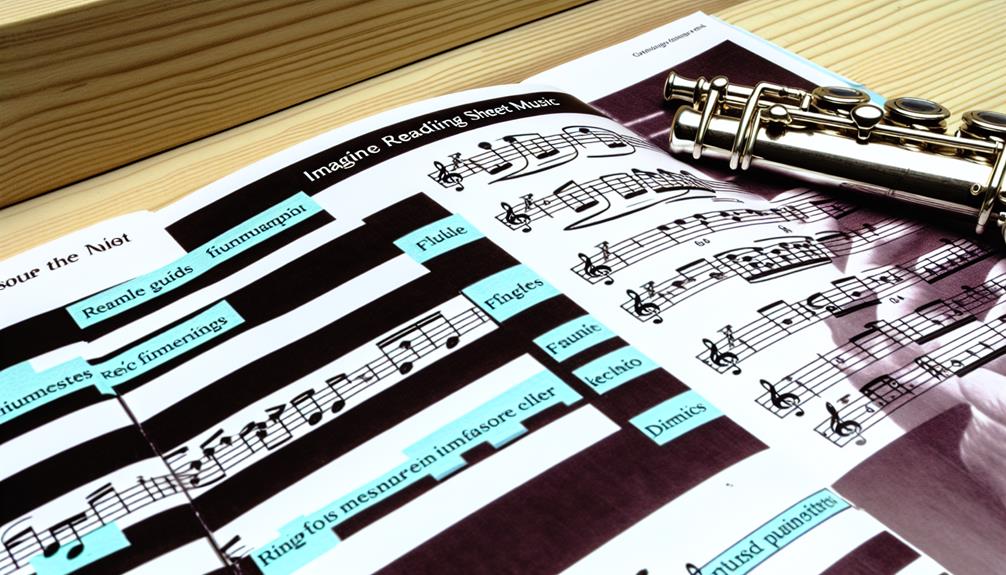Exploring the intricate realm of multiphonics on the flute unveils a tapestry of sonic possibilities that demand precision and finesse from the performer. From unraveling the complexities of acoustics to honing the subtle nuances of embouchure adjustments, mastering multiphonics is a pursuit that challenges musicians to push the boundaries of traditional flute playing. As players delve into the depths of advanced techniques, a world of expressive potential awaits, beckoning them to uncover the secrets that lie within the harmonious interplay of tones and textures.
Key Takeaways
- Explore advanced fingerings to refine tonal variations.
- Focus on precise embouchure adjustments for complex harmonics.
- Practice breath control for sustained multiphonics.
- Experiment with dynamic articulation for clear tones.
- Incorporate multiphonics creatively in musical compositions for expressive depth.
Understanding Multiphonics Fundamentals
Understanding the fundamentals of multiphonics on the flute is essential for mastering this complex technique with precision and artistry. Multiphonics refer to the production of more than one pitch simultaneously on a wind instrument like the flute. This effect is achieved by manipulating the overtones and harmonics present in the flute's sound production mechanism. When playing multiphonics, the player engages with the flute's timbre, exploring its various resonances to create a unique and layered sonic experience.
The concept of overtones and harmonics is crucial in understanding multiphonics. When a flutist plays a single note on the flute, the instrument produces a fundamental frequency along with a series of overtones, which are integer multiples of the fundamental frequency. By adjusting embouchure, airstream, and fingerings, a skilled flutist can control these overtones to produce multiple pitches simultaneously, creating a rich and complex sound texture.
Flute timbre and resonance play a significant role in the execution of multiphonics. Different fingerings and embouchure adjustments can highlight specific harmonics, resulting in varied timbres and resonances. Understanding the flute's inherent acoustical properties and how they interact with the player's techniques is essential for achieving mastery in multiphonic performance. Through dedicated practice and experimentation, flutists can unlock the full potential of multiphonics, adding depth and versatility to their musical repertoire.
Exploring Fingerings for Multiphonics
In the intricate realm of mastering multiphonics on the flute, the exploration of specific fingerings is a pivotal aspect that demands meticulous attention and experimentation. Fingering variations play a crucial role in producing multiphonics, as slight adjustments can significantly impact the resulting sound. Different fingerings can produce variations in tone quality, affecting the overall timbre and resonance of the multiphonic sound. It is essential for flutists to explore a variety of fingerings to discover which combinations yield the desired tonal characteristics for each multiphonic combination.
When delving into the realm of fingerings for multiphonics, it is not merely about finding the 'correct' combination but also about artistic interpretation and musicality. Each flutist may have a unique approach to selecting fingerings based on their personal artistic vision and the musical context in which the multiphonics are being utilized. Experimenting with different fingerings allows for greater flexibility in shaping the sound and expression of the multiphonic passages.
Furthermore, the exploration of fingerings for multiphonics opens up opportunities for creative exploration and sonic experimentation. By embracing the nuances of various fingerings and their impact on tone quality, flutists can delve deeper into the expressive possibilities of multiphonics, enhancing their musical interpretations and performances. Ultimately, mastering the intricacies of fingerings for multiphonics is a dynamic journey that enriches the flutist's sonic palette and musical capabilities.
Mastering Control of Airflow
Achieving mastery in controlling airflow is a fundamental skill that significantly influences the precision and clarity of multiphonics produced on the flute. Proper airflow control not only enhances the musicality of the performance but also ensures a balanced and rich tone that is essential for executing complex multiphonic passages.
To effectively master airflow control, flutists must focus on several key elements:
- Breath Support: Developing strong breath support is crucial for maintaining a steady airflow while playing multiphonics. Proper breath control allows the flutist to sustain the sound and transition smoothly between different multiphonic combinations.
- Tonal Balance: Achieving tonal balance is essential when producing multiphonics on the flute. Controlling the airflow to balance the primary pitch with the harmonic or noise elements ensures that all the sounds blend harmoniously, creating a cohesive multiphonic texture.
- Dynamic Air Pressure: Flutists must learn to adjust the air pressure within the oral cavity to control the intensity and volume of the multiphonics. Varying the air pressure allows for dynamic expression and helps in shaping the overall sound of the multiphonic passage.
- Consistent Air Stream: Maintaining a consistent and steady air stream is key to producing clear and well-defined multiphonics. Flutists should practice controlling the airflow to avoid fluctuations in pitch and ensure a stable sound throughout the performance.
Experimenting With Different Embouchure Techniques
To further enhance the proficiency in multiphonics production on the flute, exploring various embouchure techniques can offer valuable insights into achieving a diverse range of sonic possibilities. Embouchure variations play a crucial role in manipulating the sound and exploring the full potential of multiphonics. By adjusting the shape of the lips, jaw position, and the amount of pressure applied to the mouthpiece, flutists can create a multitude of tones and harmonics simultaneously.
Experimentation with embouchure techniques involves a systematic approach to understand how each adjustment influences the resulting sound. Players can experiment with rolling in or out the flute, altering the angle of the air stream, or even using different tongue positions to create distinct multiphonic effects. This exploration not only broadens the sonic palette but also enhances the player's control and precision in producing desired multiphonics.
Sound manipulation through embouchure experimentation opens up a world of possibilities for flutists aiming to master multiphonics. It allows for the creation of unique textures, timbres, and harmonies that can add depth and complexity to musical performances. By delving into the realm of embouchure variations and continuous experimentation, flutists can unlock the full expressive potential of multiphonics, elevating their playing to new heights of artistry.
Practicing Multiphonics Articulation
Exploring the nuances of articulation in multiphonics on the flute requires a meticulous approach to precision and control over the simultaneous production of multiple tones. When practicing multiphonics articulation, attention to detail is crucial for improving consistency and refining tone quality.
Here are some key techniques to focus on:
- Air Stream Management: Adjusting the direction and speed of the air stream is essential for producing clear multiphonic tones. Experiment with different air pressures and angles to find the optimal balance for each multiphonic combination.
- Embouchure Control: Fine-tuning your embouchure is paramount in achieving stable multiphonics. Work on controlling the aperture of your lips and the pressure against the flute's embouchure hole to maintain a steady sound.
- Tonguing Variations: Experiment with various tonguing techniques to articulate each note within the multiphonic passage distinctly. Practice double tonguing, triple tonguing, and even flutter tonguing to enhance the clarity and separation of tones.
- Dynamic Adjustments: Pay close attention to the dynamics of each multiphonic combination. Practice transitioning smoothly between different dynamic levels to add depth and expressiveness to your multiphonic passages.
Incorporating Multiphonics Into Musical Pieces
Integrating multiphonics into musical compositions requires a nuanced understanding of flute technique and a keen ear for blending harmonies within the context of a piece's overall musical structure. Creative compositions can benefit greatly from the unique textures and colors that multiphonics offer. When incorporating multiphonics, flutists must consider the harmonic implications of each multiphonic combination and how it fits within the piece's tonal palette.
Artistic interpretations play a crucial role in successfully integrating multiphonics into musical pieces. The flutist must explore how multiphonics can enhance the emotional depth of a composition or create a specific mood. Experimenting with different multiphonic fingerings and adjusting the airspeed and angle can lead to a more expressive performance.
Incorporating multiphonics into musical pieces requires a careful balance between technical precision and musical expression. Flutists should pay attention to the transitions between regular flute playing and multiphonics, ensuring that these shifts are seamless and enhance the overall musical narrative. By integrating multiphonics thoughtfully, flutists can elevate their performances and bring a new dimension to their repertoire.
Troubleshooting Common Multiphonics Challenges
Addressing common challenges encountered when performing multiphonics on the flute requires a thorough understanding of the specific fingerings, embouchure adjustments, and airflow modifications necessary to achieve clear and stable multiphonic tones. Troubleshooting these challenges involves a combination of technical skills and precision in execution. Here are some key points to consider:
- Troubleshooting Embouchure: Ensuring a proper embouchure is crucial for producing multiphonics. Experiment with different lip positions and mouth shapes to find the optimal setup for each multiphonic combination.
- Fingerings: Mastering the correct fingerings for each multiphonic is essential. Practice transitioning smoothly between fingerings to avoid disruptions in sound production.
- Airflow Control: Controlling the airflow is vital for sustaining multiphonic tones. Focus on maintaining a steady stream of air while adjusting the pressure to achieve balance between the primary and secondary tones.
- Articulation Techniques: Explore various articulation techniques to enhance the clarity and definition of multiphonic sounds. Experiment with tongue placement and speed to find the articulation that works best for each multiphonic passage.
Developing a Multiphonics Practice Routine
To effectively incorporate multiphonics into your flute playing repertoire, establishing a structured and focused practice routine is paramount. When developing a practice routine for multiphonics, consider incorporating exercises that focus on breath control and tone quality. Begin by dedicating a specific portion of your practice session to multiphonics to ensure consistent improvement.
Start by working on breath control exercises such as long tones and slow scales to strengthen your ability to control the airstream. Multiphonics require precise manipulation of air pressure and direction, making breath control a crucial aspect of mastering these techniques. Focus on maintaining steady airflow while exploring different fingerings to produce multiple pitches simultaneously.
Additionally, concentrate on tone quality when practicing multiphonics. Pay attention to the balance between the primary pitch and the additional tones, aiming for a clear and resonant sound. Experiment with different embouchure positions and air speeds to achieve a well-rounded and rich multiphonic sound.
As you develop your multiphonics practice routine, ensure consistency and patience. Set specific goals for each practice session, gradually increasing the complexity of the multiphonic passages as you improve. By prioritizing breath control and tone quality in your practice routine, you will enhance your ability to perform multiphonics with precision and confidence.
Enhancing Expressiveness Through Multiphonics
Enhancing expressiveness through multiphonics on the flute involves infusing intricate layers of harmonic richness into your musical phrases, elevating the depth and emotive quality of your performance. When exploring this advanced technique, creative interpretations and emotional expressions are key elements that can significantly enhance the expressiveness of your music.
Here are some strategies to help you achieve this:
- Experiment with Different Fingerings: By varying your fingerings and exploring alternative combinations, you can create unique multiphonic sounds that add a new dimension to your music.
- Focus on Dynamic Control: Pay attention to the dynamics of each multiphonic passage, adjusting the intensity and volume to convey different emotional nuances within the piece.
- Blend Multiphonics with Traditional Techniques: Integrate multiphonics seamlessly with traditional flute techniques to create a cohesive and expressive musical narrative.
- Use Multiphonics to Convey Specific Emotions: Explore how different multiphonic combinations can evoke specific emotions, allowing you to communicate complex feelings through your music.
Collaborating With Other Musicians on Multiphonics
Collaboration with other musicians on multiphonics requires a nuanced understanding of each player's individual sound production techniques and an adept synchronization of harmonic layers to create a cohesive and harmonious musical blend. When improvising with multiphonics, it is crucial for musicians to listen attentively to one another, adjusting their playing in real-time to complement and enhance the overall sonic landscape. This process involves a delicate balance of experimentation, active listening, and mutual respect for each musician's unique contribution to the collective sound.
Collaborating creatively with other musicians on multiphonics opens up a world of possibilities for sonic exploration and musical expression. By combining different multiphonic techniques, musicians can create rich textures and intricate harmonies that transcend the limitations of traditional flute playing. Through open communication and a willingness to explore new ideas, musicians can push the boundaries of multiphonic performance, creating innovative and captivating music that captivates audiences and inspires future generations of musicians.
Frequently Asked Questions
Can Multiphonics Be Used in All Genres of Music?
Multiphonics, a complex technique where multiple notes are produced simultaneously on the flute, can be creatively applied across various music genres. While historically more prevalent in avant-garde and experimental music, its use has expanded to encompass diverse styles.
Cultural influences also play a role in the integration of multiphonics, with some genres embracing it more readily than others. Its versatility allows for inventive expressions in music, showcasing the flute's potential for innovation and exploration.
Are There Specific Health Risks Associated With Playing Multiphonics?
When exploring the realm of multiphonics in flute playing, it is essential to be mindful of potential health risks that may arise. These risks can include muscle strain, fatigue, and even potential damage to the respiratory system if not executed with proper technique.
To mitigate these risks, flute players should focus on maintaining proper posture, incorporating regular breaks during practice sessions, and seeking guidance from a qualified instructor to ensure a safe and sustainable approach to mastering multiphonics.
How Can Multiphonics Be Notated in Sheet Music Effectively?
When notating multiphonics in sheet music, composers face notation challenges due to the complex nature of these sounds. Effective notation involves using symbols, diagrams, and written instructions to convey the desired multiphonic technique clearly to the performer.
It is crucial to consider musical interpretation, allowing for artistic expression within the performance. Performers should explore different performance techniques to master multiphonics, enhancing their ability to execute these complex sounds with precision and creativity.
What Are Some Tips for Improvising With Multiphonics?
When exploring tonalities and engaging in creative phrasing, improvising with multiphonics on the flute can be a captivating endeavor.
To excel in this art, it is essential to experiment with different fingerings and embouchure techniques.
Are There Any Electronic Effects That Can Enhance Multiphonic Sounds?
Electronic enhancements can significantly alter multiphonic sounds on the flute, providing a wide range of creative possibilities. Sound manipulation tools like delay, reverb, and pitch shifting can transform the timbre and spatial characteristics of multiphonics, adding depth and complexity to the sonic landscape.
Conclusion
In conclusion, mastering multiphonics on the flute requires a deep understanding of acoustical properties, precise control over fingerings, embouchure, and airflow. By exploring various techniques and practicing diligently, flute players can unlock the full potential of multiphonics, adding depth and complexity to their musical performances.
With dedication and perseverance, musicians can achieve a wide range of tonal colors and textures, enhancing their expressiveness and musicality.
Stay tuned for more advanced techniques and insights into the world of multiphonics on the flute.





